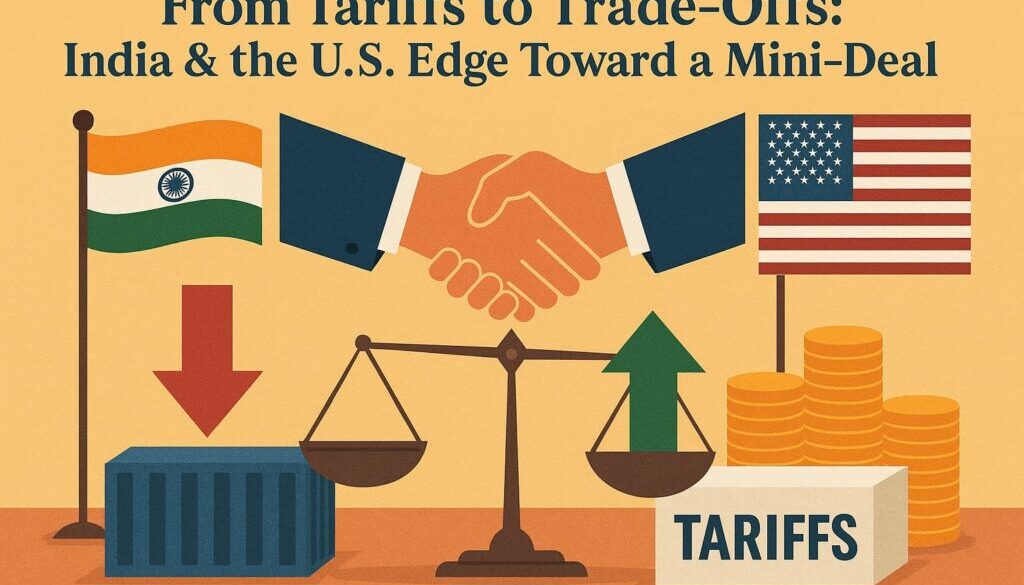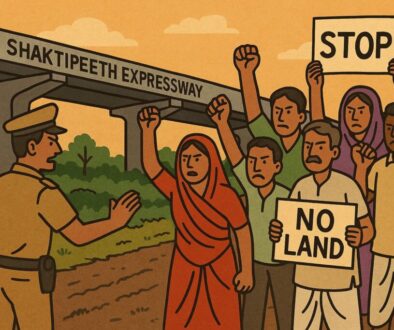From Tariffs to Trade-Offs: India & the U.S. Edge Toward a Mini-Deal
India and the United States are using a limited “early-harvest” package to unlock quick tariff cuts and market-access wins while they negotiate a full free-trade agreement. Under WTO rules such interim deals must still respect Article XXIV disciplines (eventually liberalising “substantially all trade”) and cannot raise new barriers; they also have to be notified and reviewed. The mini-deal is therefore being chiselled around four static pillars every UPSC candidate should know: (1) what the WTO says about early-harvest agreements, (2) the difference between tariff and non-tariff barriers that the two sides are haggling over, (3) the seldom-invoked Balance-of-Payments safeguard in Article XII GATT, and (4) how India’s Foreign Trade Policy 2023 sets the domestic ground rules for any concessions. The sections below unpack each handle in detail and link them back to the India–U.S. corridor.
WTO rules on “early-harvest” agreements
What is an early-harvest?
Informal term for a partial set of commitments that partners implement before the rest of their free-trade agreement (FTA) is ready. WTO jurisprudence treats such packages as interim agreements under Article XXIV:5(c) GATT (goods) or Article V GATS (services). They must:
- Be notified to the WTO Committee on Regional Trade Agreements (CRTA).
- Contain a plan & schedule showing how the parties will reach a full FTA covering “substantially all the trade” within a “reasonable length of time” (normally 10 years, exceptionally 12).
- Not raise new barriers against outsiders while the interim phase is in force.
How has “early harvest” been used?
Deal: ASEAN–China (2004)
Coverage unlocked early: Zero duties on 573 “early-harvest” farm products
Full FTA deadline: Completed 2010
WTO notification: Notified as goods RTA #C-38
Deal: India–Thailand (2004)
Coverage unlocked early: 82 tariff lines liberalised at once
Full FTA deadline: Still under negotiation
WTO notification: Notified as interim RTA #C-39
Deal: Doha Round idea (Trade-Facilitation text)
Coverage unlocked early: Developed countries proposed TF text as an early harvest; South-Centre warned of burden on developing members
Full FTA deadline: Doha Round collapsed
WTO notification: N/A
Why does it matter for the India-U.S. mini-deal?
New Delhi and Washington are packaging “early wins”—auto-parts tariff cuts and a small set of SPS concessions—in time for a July 2025 deadline.
Because it will be notified as an interim Article XXIV deal, the two sides must spell out how they will widen coverage to meet the substantially-all-trade test—an issue likely to appear in mains “critically examine” questions.
Tariff vs Non-tariff barriers (NTBs)
Feature: Form
Tariff barriers: Customs duties, specific or ad-valorem
Non-tariff barriers: Quotas, licensing, SPS/TBT standards, local-content rules
Feature: Revenue
Tariff barriers: Generates tax income for the importing state
Non-tariff barriers: Usually no revenue, raises compliance costs
Feature: WTO Discipline
Tariff barriers: Bound in each member’s Schedule under Article II of GATT
Non-tariff barriers: Governed by separate agreements (SPS, TBT, Import Licensing)
Current India-U.S. flash-points
Tariff barriers:
- U.S. Section 232 steel/aluminium duties (25%, 10%) — India wants removal
- India’s 150% duty on U.S. premium nuts — Washington wants reduction
Non-tariff barriers:
- India’s dairy SPS regime (cow-genetic purity and hormone-free certification)
- U.S. facility-registration requirements for Indian seafood exports
Balance-of-Payments safeguard – Article XII GATT
Clause: Art XII:1
Practical meaning: Permits temporary import restrictions “in order to safeguard the external financial position and the balance-of-payments”
Clause: Proportionality
Practical meaning: Measures must not exceed what is necessary; quotas are preferred over surcharges
Clause: IMF role
Practical meaning: Contracting party must consult the IMF; WTO must accept IMF findings on reserve adequacy (Article XV)
Clause: Transparency
Practical meaning: Member must notify, publish, and progressively relax restrictions as balance-of-payments improves
When used?
India itself invoked Art XII during the 1991 BoP crisis to maintain cash-margin restrictions on imports—classic prelim fodder.
Why relevant now?
If a future India-U.S. tariff reduction narrows India’s customs revenue, policymakers might debate BoP safeguards; UPSC can draw a static MCQ on who administers such consultations (Ans: WTO + IMF).
India’s Foreign Trade Policy 2023 – domestic backdrop
Pillar (FTP 2023): Ease of doing business
Key provisions: End-to-end paperless authorisations, lower fees, automated risk management
UPSC angle: Improves utilisation of concessions under early-harvest deal
Pillar (FTP 2023): Merchanting trade & e-commerce
Key provisions: Allows merchanting of restricted goods; raises e-commerce courier cap to ₹10 lakh
UPSC angle: Helps SMEs ride tariff preferences—good mains case study
Pillar (FTP 2023): Towns of Export Excellence & District hubs
Key provisions: Grass-roots export promotion, capacity-building of status holders
UPSC angle: Links to GS-II “cooperative federalism” and GS-III employment.

